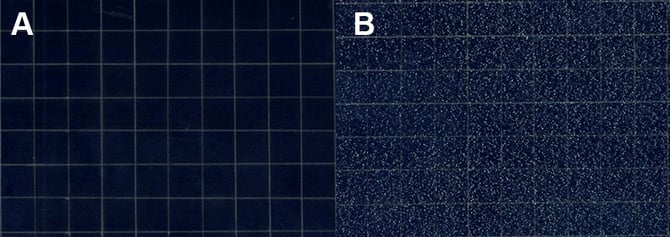
How MFC can improve durability and performance of your boat
Synnøve Holtan | February 14, 2017
In my previous blog post, I covered the characteristics of microfibrillated cellulose (MFC) and fumed silica as raw materials used for industrial purposes. I focused on how MFC provides a viable alternative to fumed silica in many applications since they both have large surface areas with similar surface active groups. However, the physical network properties of the two materials differ and may lead to new and exciting discoveries in the end products.
Here at Borregaard, we discovered one of the unique effects of microfibrillated cellulose on cured gel coat composites: improved air release. This can be utilized, for example, in the marine industry, where a durable outer surface is crucial. Compared to the reference gel coat with hydrophilic fumed silica, the number of pores were dramatically reduced when using MFC. In this blog post, I will demonstrate how MFC can be used to achieve pore-free gel coats, and the desired effects it represents for your speed boat.
Learn more: MFC vs. Fumed Silica: Characteristics and applications
Pore-free, high-protective gel coat containing microfibrillated cellulose
Gel coats are coatings applied as a protective and decorative outer layer on thermoset or thermoplastic composite materials. They are mostly based on epoxy or unsaturated polyester resin and have a variety of uses in marine, transportation and other industries. Application of gel coats is similar to paints and can be done via brushing or spraying. Gel coats are cured to form cross-linked polymers and designed to be highly durable providing resistance to ultraviolet degradation and hydrolysis - in particular, blistering in water. Fumed silica and thixotropic additives (modified glycols) are applied in gel coats, giving the gel coat the desired thixotropic (shear- and time-dependent) viscosity profile. This characteristic is essential to ensure proper gel coat properties during storage, application and for the cured state on laminate. If porosity in the final gel coat layer occurs, it reduces the quality of the film and weakens the water and weather (UV) resistance properties. A general problem creating significant cost in repairing and finishing work. An air release additive is usually added to reduce the inclusion of air and formation of pores.
In our study at Borregaard (WO2010105847), we made two unsaturated polyester gel coats; one with hydrophilic fumed silica, a thixotropic additive and a commercially available air release additive (fumed silica reference), and one where we substituted the abovementioned three additives with microfibrillar cellulose (MFC gel coat). We used a dry MFC quality at half the level of fumed silica to give a comparable rheological effect, like thixotropy, as well as gel coat stability. During application, the spraying ability out of the nozzle was better for the MFC based gel coat than for the fumed silica reference.
For the cured gel coats the results were most striking and unexpected: The MFC had removed all the air bubbles from the gel coat. As seen in Figure 1 below, the MFC based gel coat was pore-free, whereas the fumed silica reference gel coat had a significant amount of small pores. The absence of pores throughout the MFC coating layer was confirmed at various penetration depths of the applied hardened film, by grinding of the laminated gel coat composites. By comparison, the reference silica based sample showed a significant number of pores at all levels of film depth investigated. The mechanism behind the observed air release effect is most probably related to the physical nature of MFC. The three-dimensional web of long and thin fibrils may capture the air being present from onset or occurring from the application process, and provide a fast release of the trapped air before or during curing of the gel coat.

Figure 1. Gel coat with microfibrillated cellulose, 0 pores/cm2 (A) and the reference gel coat with fumed silica, 272 ±22 pores/cm2 (B). Gel coats were mixed with 1.5% peroxide and sprayed onto flat vertical fiberglass plates using the Applicator IPG-8000 until a wet film thickness of 800 µm. The area pore density of the two hardened gel coats was determined by grinding off the upper surface layer, and by means of an optical microscope counting the pores (white dots) for 100 squares of 1 cm2 each, resulting in an average number of pores per cm2.
MFC can provide an innovative additive for future green composites
Being open minded and explorative in application innovations, testing new raw materials out of the standard ‘additive kit/toolbox’ may lead to unexpected and beneficial effects on the end products. MFC is not a typical material used in gel coat formulations, but it has well-proven functionalities such as rheology modification and as a thixotropic additive. Moreover, and most surprisingly, the gel coat with MFC demonstrated a complete avoidance of pore formation. The mechanism behind this very interesting air release effect is most probably related to the physical network structure of MFC.
Reducing porosity is of outermost importance to increase the lifetime of the composite products. Moreover, for boats specifically, to prevent increased weight and fuel consumptions due to water uptake. The demand of lowering the volatile organic content (VOC) of gel coats may imply an increase in gel coat viscosity, which again escalates the request and importance of an effective air release agent. Microfibrillar cellulose is a green, no-VOC material; can MFC be the new combined rheology and air release agent for future high protective, environmentally friendly gel coats?
Written by:
Synnøve Holtan
Synnøve Holtan has worked with microfibrillated cellulose MFC since 2005 and has developed an in-depth understanding of the product characteristics, as well as production processes and application innovation. As a senior scientist at Borregaard she focuses on the analyses and performance of Exilva in industrial applications, such as coatings and adhesives. Synnøve has a PhD in biopolymer chemistry from the Norwegian University of Science and Technology.
